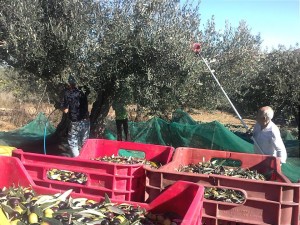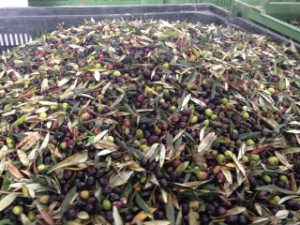Si chiama Bactrocera olea, più comunemente nota come mosca dell’olio, ed è l’insetto che ha distrutto gran parte degli oliveti abruzzesi (colpendo soprattutto la varietà del leccino) provocando, di conseguenza, una forte crisi dei coltivatori messi in ginocchio da una drastica riduzione nella produzione.
L’assalto della mosca è stato più consistente rispetto a quelli precedenti del 1990 del 2000, anni in cui aveva già provocato danni consistenti, a causa del clima insolitamente umido dei mesi estivi, condizione ideale per il proliferare dell’insetto che ha avuto cosi il sopravvento sulle colture abruzzesi e su quelle di altre regioni d’Italia.
All’attacco della mosca è andata ad aggiungersi un’altra malattia provocata da un fungo, la lebbra dell’olivo, che quest’anno ha danneggiato le piante provocando gravi defogliazioni e comportando, soprattutto, un aumento di acidità dell’olio.
I vari trattamenti, atti a rendere le olive meno appetibili per l’insetto, hanno arginato di poco il problema.Effetto di tutto ciò è stato un drastico calo di produzione che si stima tra il 50 e il 70 % in meno rispetto agli anni precedenti. I danni, come si può ben immaginare, sono numerosi e di varia natura.
Coltivatori spaesati
“Non mi ricordo un’annata così dal 1985. I coltivatori si sono trovati spaesati perché non sono abituati a fare trattamenti a luglio, come avrebbero dovuto fare quest’anno a causa dei fattori climatici, umidità e piovosità, che hanno favorito l’attecchimento della mosca” – spiega Luciano Pollastri, funzionario agronomo della Direzione Agricoltura della Regione Abruzzo. “Chi è riuscito ad attuare una buona strategia di controllo e a salvare il prodotto, ha dovuto fare più di un trattamento fitosanitario, nel rispetto dei tempi di carenza, quelli cioè in cui l’insetticida si dissolve. Ritengo che nonostante i ripetuti trattamenti, non ci siano pericoli per i residui nocivi visto che in Abruzzo più del 40% dei coltivatori fa autoproduzione, cioè produce e consuma l’olio e quindi è particolarmente attento ai trattamenti”.
A pagarne le conseguenze, dunque, sono stati in primis i coltivatori che hanno visto soccombere gli uliveti piegati dinnanzi all’insetto assassino. Molti di loro hanno addirittura deciso in extremis di non raccogliere i frutti di tanti sacrifici. Il danno è stato soprattutto economico per le piccole e medie imprese agricole che vedendo andare a male l’intero raccolto hanno perso una cospicua fonte di guadagno. La Coldiretti,nel corso di un incontro con l’assessore regionale all’agricoltura Dino Pepe, ha chiesto con forza l’attivazione delle procedure per il riconoscimento dello stato di calamità naturale previsto dal decreto legislativo n.102/04 per gli eventi non assicurabili.
Frantoi chiusi
Anche per i frantoiani non è stato facile affrontare questo flagello, avendo a che fare con una situazione singolare: mancanza di olive ha significato per loro mancanza di lavoro. Sono stati numerosi coloro che hanno lavorato meno dei soliti quaranta giorni degli anni precedenti e che sono stati costretti a chiudere anticipatamente; altri invece hanno deciso di non aprire i battenti, consapevoli della mancanza di lavoro.
Chi ha lavorato, ha lavorato a stento, dovendo gestire a volte situazioni non facili: “Ci sono stati casi in cui, per salvaguardare il cliente e il frantoio, abbiamo dovuto rifiutare la molitura di olive molto danneggiate.” – racconta un frantoiano. “Molinare olive malate compromette non solo il prodotto finale ma anche le successive moliture”. La mancanza di olive sane ha portato ad una resa scarsa, 8 litri per quintale rispetto ai 12/16 litri degli anni passati. I proprietari dei frantoi hanno cosi subìto danni finanziari ingenti. Infatti oltre ai costi di routine molti di loro, avendo fatto grandi investimenti negli anni scorsi, passando dal cosiddetto frantoio tradizionale a quello a ciclo continuo, sono statti costretti a chiedere prestiti e finanziamenti per far fronte alle spese in mancanza di lavoro.
Prezzi alle stelle
Ma la situazione è allarmante non solo nel nostro Abruzzo, la condizione delle coltivazioni di olivo nel resto del Paese è pressochè la stessa.
Ovviamente gli effetti di questa vera e propria epidemia andranno inevitabilmente a ripercuotersi sulle tasche dei consumatori che, come spiega il delegato regionale Coldiretti giovane impresa Abruzzo, Piercarmine Tilli, vedranno aumentare il prezzo del prodotto: “Se infatti il costo dell’olio l’anno scorso si aggirava intorno ai sei euro al litro, quest’anno il prezzo è lievitato fino a raggiungere i dieci, dodici euro al litro. Chi produce e ha contratti per distribuire l’olio avrà molte difficoltà a mantenerli. Dovrà prenderlo da altri”.
Il danno inciderà anche sulle caratteristiche del prodotto che arriverà sulle nostre tavole, un raccolto come questo produrrà olio con un acidità molto elevata che andrà ad inficiarne la qualità. “La mancanza di olio nel nostro Paese” – afferma ancora Tilli – “farà aumentare in maniera esorbitante l’importazione di olio straniero, derivato dai paesi mediterranei limitrofi come Tunisia e Spagna. L’unico modo possibile al consumatore per tutelarsi è comprare olio da venditori di fiducia che possano attestarne la qualità e la provenienza, oltre a controllare le diciture IGP e DOP sulle etichette che devono garantirne l’origine”.
L’olio vecchio è buono?
Olio nuovo, dunque, a peso d’oro ma anche chi conserva una scorta di quello vecchio la vende a caro prezzo.
“Non è vero che l’olio vecchio è più buono, non migliora con il passare del tempo, anzi perde ancora di più le sue caratteristiche, è più facile che si ossidi, quindi non si può immaginare di consumarlo fino al 2015. Bisogna sempre preferire l’olio nuovo” – conclude Luciano Pollastri. “La scarsa produzione avrà ripercussioni anche sullo scaffale perché il fenomeno ha riguardato tutto il paese. Consigli , dunque, di stare attenti ai prezzi troppo bassi perché quasi certamente nelle bottiglie ci sarà una miscela di oli vecchi e nuovi. Chi lo desidera può interpellare i nostri tecnici per avere pareri e consigli.”
Glenda Seccamonte
[divider]
The olive fruit fly and the humid weather destroy the olive industry . The olive prices increase.
The olive fruit fly (Bactrocera oleae) is destroying most of olive groves in Abruzzo, in particular the leccino type. A great crisis has damaged the farmers income, who are suffering a production decrease. The fly attack has been stronger than those in 1999 and 2000, when it hurt the fields widely due to the unusual hot-humid climate during the summer. It was the best condition for the insect proliferation , which destroyed the cultivations both in Abruzzo and in Italy. The olive tree leprosy added to the fly attack. It is a disease originating from a mushroom that has caused serious defoliation and an increase in oil sourness this year. Many treatments have been used to reduce the olive attractiveness in vain. The production decreased by 50-70% compared to the previous years and there are still several and different damages.
Bewildered farmers
“ I can’t remember such a year since 1985. The farmers were unprepared because they are not used to making treatments in July, although they should have paid attention to climatic factors, humidity, rain which caused the fly breeding”, explains the agricultural agent of Direzione Agricoltura Regione Abruzzo Luciano Pollastri. “ Few farmers were able to organize a good control strategy and save the product. They had to plan more than one plant protection treatment. It was important to pay attention to the pre-harvest interval, i.e. the time span the treatment takes to dissolve. Despite the repeated treatments, I think that there will be no problems linked with toxic waste. More than 40% of farmers produce their own oil and they are really careful about treatments.” The farmers were the most damaged industry and had to watch the olive tree grove being killed by the lethal insect. Most of them eventually decided not to enjoy the fruits of their labor. It was a huge economic loss for small and medium-sized businesses, whose income was largely decreased due to the damaged harvest. The Coldiretti association has strongly demanded that the state of emergency would be soon validated during a meeting with the regional agricultural minister Dino di Peppe. The procedure is provided by the 102/04 law for non-insurable damage events.
Closed Oil mill
It should have not been easy even for the oil mill owners, who faced an unusual situation: lack of olives means no job. Most of them were forced to work less than the usual 40 days and to close early; others did not open the doors, knowing that there was no job. The only small working group faced a lot of problems. “ We had to avoid the milling of damaged olives as to protect the clients and the oil mill” says an oil-mill owner. “ The milling of damaged olives threaten both the final product and the next millings. The lack of ripe olives led to a small profit, 8 liters per 100 weight compared to 12/16 (liters) in the past years. The oil-mill owners suffered a huge economic loss. In addition to usual expenses, most of them made a great economic investment: the usual oil press was replaced by a new one with a continuous cycle system. The owners were forced to take out loans due to the lack of work as well.
Sky-high prices
It is the same situation both in Abruzzo and in the other olive tree farms in Italy. The effects of this epidemic will hit consumers in the pocket. They will see rising prices, as the regional delegate of Coldiretti giovane impresa Piercarmine Tilli says. “The oil price increased this year till 10,12 per liter, while it was estimated around 6euros per liter during the last years. The producers will face many problems regarding the oil production and supply. They must buy it from other companies.” The damage will affect also the product features ,this kind of harvest will produce a very sour oil of lower quality. “ The lack of oil will rise the imports from the neighbouring countries such as Spain or Tunisia” says again Tilli. The consumers can protect themselves only buying the oil from trusted sellers who can prove its quality and source. They should check the tag with the Protected Geographical Indication (PGI) and Protected Designation of Origin (PDO) which must prove the source.
Does the old oil taste good?
Both new and old oil cots a fortune. “It is not true that the old oil tastes better, it doesn’t improve as the years go by. It is more likely to lose its shapes and oxidise. We cannot consume it till 2015, we should choose the new one” ends Luciano Pollastri. “ The lacking production will have negative effects on the prices because the whole country was hit. It is important to pay attention to low prices, many bottles will contain a mix of new and old oil. Our experts can be asked for advice”. (traduzione a cura di Paolo Sulpizi)
[divider]
Die Olivenfliege und das feuchte Klima zwingen den Ölbereich in die Knie. Die Ölpreise explodieren für das Öl.
Die Olivenfliege (Bactrocera oleae) hat verschiedene Olivenheime, vor allem die Laccino Sorte, in den Abruzzen zerstört. Die schwere Krise hat den Verdienst der Bauern beschädigt, die eine Senkung der Produktion erleiden. Der Überfall der Fliege ist stärker gewesen, als die 1990 und 2000, als das Insekt die Felder wegen des feuchtes Klimas sehr geschadet hat. In diesem optimalen Klima konnte die Fliege wuchern und die Felder in den Abruzzen und Italien zerstören. Neben der Olivenfliege ist auch die von dem Pilz entstehende Krankheit „Lepra“ der Olivenbäume aufgetaucht , die dieses Jahr der Pflanze geschadet hat und den Blattverlust und die Erhöhung der Ölsäure ausgelöst hat. Es wurde auch verschiedene Pflege umsonst eingesetzt, um die Probleme zu stoppen. Die Produktion ist um 50-70% verglichen mit den letzten Jahren gesunken. Es gibt natürlich verschiedene Schaden.
Verwirrte Erzeuger
„Ich erinnere mich nicht an ein solches Jahr seit 1985. Die Erzeuger fühlten sich unbehaglich, weil sie an den Mitteleinsatz im Juli nicht gewöhnt sind. Die Verwurzelung der Fliege wurde durch Klimafaktoren, die Feuchtigkeit und den Regen verursacht“ sagt der Agrarfunktionär von Direzione Agricoltura Regione Abruzzo Luciano Pollastri. „ Einige Erzeuger konnten eine gute Kontrolle planen und die Ernte schützen. Aber sie mussten mehrere Pflanzenschutzmaßnahmen erledigen und darauf warten, dass sich das Pflanzenschutzmittel auflöste. Trotzt den wiederholten Behandlungen denke ich, dass man keine schädlichen Gefahren noch mehr läuft. Mehr als 40% der Erzeuger in den Abruzzen erzeugen und bauen das Öl persönlich an, sie beachten die Behandlungen besonders“ Die Erzeuger waren den beschädigtsten Bereich und sie mussten die von dem Insekt getöteten Olivenhaine schauen. Die meisten von ihnen haben am Ende auch entschieden, die Früchte ihrer Arbeit nicht zu ernten. Das war ein wirtschaftlicher Verlust für die kleinen und mittleren Unternehmen , deren Verdienst wegen der ruinierten Ernte gesunken ist. Die Farmunion Coldiretti hat während einem Treffen mit einem regionalen Landwirtschaftsminister Dino Peppe verlangt, dass die Lage laut dem italienischen Artikel 102/04 für nicht versicherbare Risiken zum Notstandsgebiet erklärt würde.
Verschlossene Ölmühlen
Die Ölproduzenten haben wegen der Geißel auf Schwierigkeiten auch gestoßen, weil sie eine Speziallage erfahren haben: der Mangel an den Oliven bedeutet keine Arbeit. Viele von ihnen haben wenig als die üblichen 40 Tage gearbeitet und mussten früher schließen. Da sie sich des Mangels der Arbeit bewusst waren, haben andere Ölproduzenten entschieden, sogar nicht zu beginnen. Wenige von ihnen haben gearbeitet und haben die schwierige Situation gestellt.“ Manchmal mussten wir das Pressen der sehr beschädigten Oliven vermeiden, um die Verbraucher und die Ölmühle zu schützen“ erzählt ein Ölproduzenten. „ Das Pressen von beschädigten Oliven gefährdet nicht nur das finale Erzeugnis sondern auch die nächsten Pressen.“ Der Mangel an gesunden Oliven hat ein mageres Ergebnis verursacht, 8 Liter pro Doppelzentner statt 12-16 Liter in den vorigen Jahren. Die Besitzer der Ölmühlen haben riesige wirtschaftliche Schäden erlitten. Neben den üblichen Ausgaben haben viele von ihnen sehr investiert, um die traditionelle Ölpresse durch die kontinuierliche Ölpresse zu ersetzen. Sie sollten Darlehen aufnehmen, weil sie kein Geld hatten, um die Kosten auf sich zu nehmen
Die Preise explodieren
Die drastische Lage gibt es nicht nur in Abruzzo sondern auch in allen Anbaugebieten in dem ganzen Land. Der Regionalbeauftragte Piercarmine Tilli von „Coldiretti giovane impresa Abruzzo“ erklärt, die Verbraucher würden die Preise steigen sehen. Die Ergebnisse der Epidemie würden den Interessen der Verbraucher schaden. „ Der Ölpreis belief sich auf etwa 6 Euro pro Liter in den letzten Jahren, während er um 10-12 Euro pro Liter dieses Jahr gestiegen ist. Die Erzeuger werden viele Probleme mit der Herstellung und der Lieferung haben. Sie müssen von anderen kaufen“
Die Schäden werden sich auf das kommende Produkt schlecht auswirken. Eine solche Ernte wird ein saures Öl erzeugen, das eine niedrigere Qualität erreichen wird. „Wenig Öl wird die Einfuhr aus den Grenzstaaten wie Spanien oder Tunesien sehr steigern“ sagt Tilli noch. „ Der Verbraucher kann sich schützen, erst wenn er das von den Vertrauensverkäufer kauft, die die Herkunft und die Qualität bestätigen kann. Die Etikette IGP (g.g.A.) und DOP(g.U.) müssen den Herkunftsort garantieren.“
Schmeckt das alte Öl gut?
Das neue Öl ist Gold wert, aber wer einen alten Vorrat hat, verkauft es teuer. „ Es ist nicht wahr, dass das alte Öl besser ist und mit der Zeit besser wird. Es verliert die besondere Eigenheit immer mehr und oxidiert eher. Man kann nicht denken, das bis 2015 zu verzehren. Das neue Öl ist am besten“ schließt Luciano Pollastri. „ Die knappe Herstellung wird auch auf die Preise Auswirkungen haben, weil das Ereignis das ganze Land getroffen hat. Man muss auf die niedrigen Preise aufpassen, weil die Flaschen eine Mischung aus neuem und altem Öl enthalten. Unsere Fachleute können zur Beratung hinzugezogen werden (traduzione a cura di Paolo Sulpizi)









